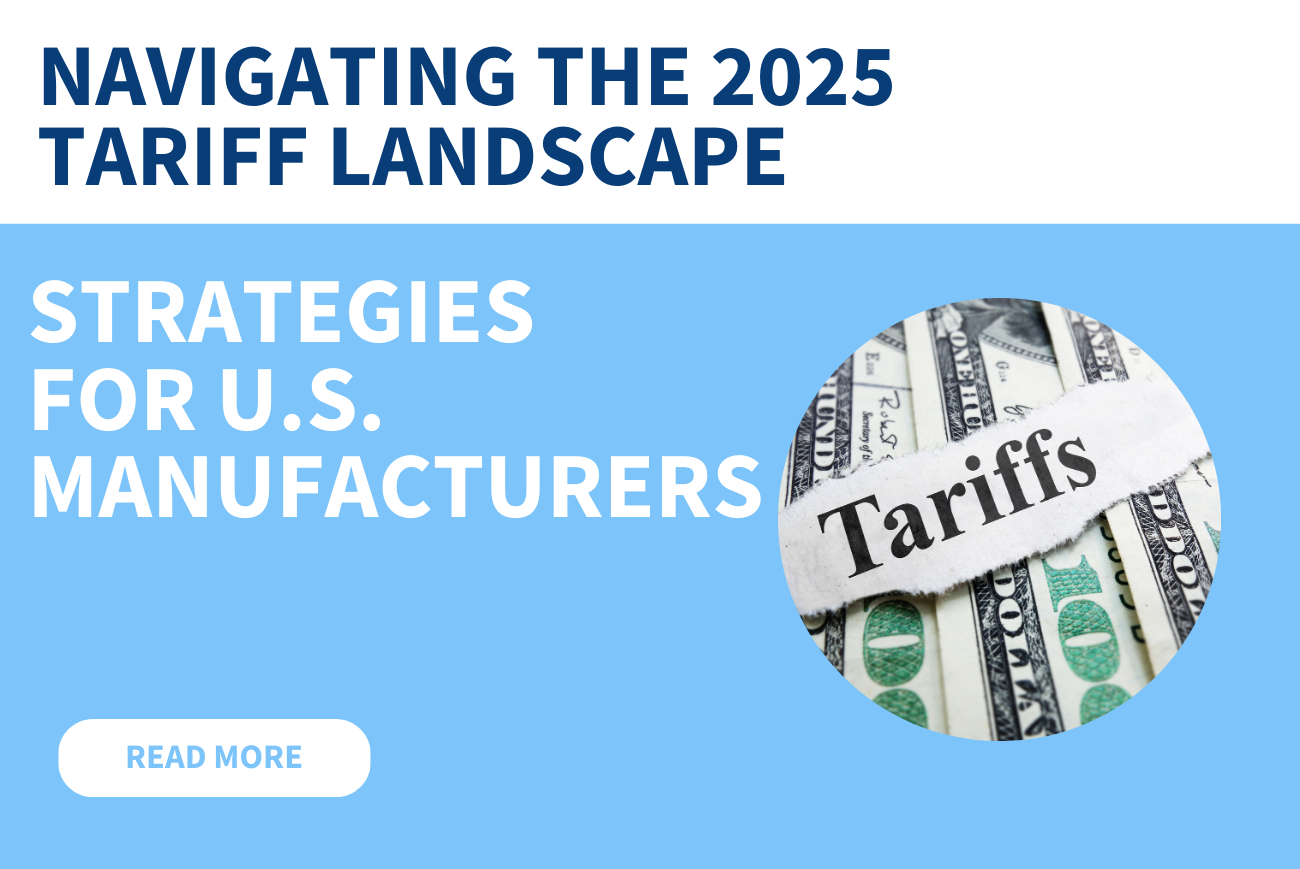Why are Sustainable Supply Chains Important?
Did you know that 76.6% of U.S. emissions are driven by manufacturing production? There is heightened pressure on manufacturers to focus on sustainable supply chain processes as a vital key to the preservation of our planet. A best practice for supply chain manufacturers is to focus on reducing inventory to free working capital but also minimize their carbon footprint.
What makes a sustainable supply chain?
According to the Sustainable Supply Chain Foundation (SSCF), “Sustainable supply chain management involves integrating environmentally and financially viable practices into the complete supply chain lifecycle, from product design and development to material selection, (including raw material extraction or agricultural production), manufacturing, packaging, transportation, warehousing, distribution, consumption, return, and disposal.”
This means that all parts of the complex supply chain have the potential for product waste and harmful greenhouse gas emissions—but also the opportunity for improvement and resiliency. Sustainable companies take environmental factors into account in business processes and are Earth-friendly at all levels.
What can manufacturers do to reduce their impact on the environment?
Everything manufacturers do affects the environment in different ways; from pollution created by business processes to waste from overproduction. Here are some ways manufacturers can be greener:
1. GREENER TRANSPORTATION
One huge way to reduce carbon footprints is to look at how materials are transported throughout supply chains. Using a plane to fly products and materials is going to have a much larger greenhouse gas emission than a different mode of transportation, such as a boat or train.
Advancements in electric vehicles are also starting to provide green alternatives, like utilizing diesel instead of less-efficient gasoline.
While enterprises are often at the mercy of expediting materials as fast as they can, alternate transportation methods or complete visibility into future shortages or late deliveries can help mitigate those risks.
2. RECYCLED MATERIALS
Green manufacturers look closely at the materials in their products. Some materials are considered to be more green than others, including recycled materials and compostable packaging. This reduces waste otherwise produced by creating new materials from scratch. Reducing the amount of raw material inputs not only saves costs but saves the environment.
One conundrum is the use of plastic, metals, and other synthetic materials. Plastics can be lighter (and therefore less costly to transport), produced more efficiently, and in some cases, recyclable.
However, as we’ve seen, these materials have devastating effects at the end of the supply chain, as waste ends up in oceans and decomposes slowly. These trade-offs create complex design and sustainability issues for manufacturers.
3. SUSTAINABLE SUPPLIERS
Manufacturers can also commit to being greener by having insight into where they source their materials. Companies can make the conscious choice to use suppliers who have already made a commitment to being green or require it as a condition to be an approved supplier.
Some sustainable companies put requirements in procurement contracts like Master Purchase Agreements to provide guidelines to ensure suppliers are managing waste, managing their carbon footprint, and recycling materials accordingly.
One example where this is put into practice is government contracting. To be eligible for certain government contracts, companies like Lockheed Martin, Boeing, and Raytheon are required to meet certain sustainability targets in their own factories and throughout their supply chains. This helps incentivize companies to improve their sustainability practices.
4. REVERSE LOGISTICS
Manufacturers can ensure the flow of goods for service and sale is cost-effective and sustainable. If you have parts coming to a warehouse and parts that need to be sent back for servicing, make it one trip instead of two. Often, the transporter dropping off the parts can also pick up your returns. You can repurpose assets that have some salvage value at the end of the useful life of their initial task.
There are software providers out there who focus entirely on logistics and reverse logistics. Not only is it good for the environment, but optimizing logistics flows has a direct impact on the bottom line of a company: A win-win.

5. REDUCE INVENTORY
1 out of 7 types of waste identified in lean thinking is inventory:
- All components
- Work-in-progress
- Finished goods not in production
To decrease the negative impact we have on our planet, manufacturers can focus on inventory reduction efforts, so that levels more closely match demand.
A sustainable inventory strategy means inventory is produced as needed, so less inventory becomes obsolete over time and wastes away in a warehouse, but not at the cost of critical shortages and late fees
The balance does exist between having enough inventory at the right time without being “too lean.”
Another green way to manage obsolete inventory?
Create and promote new designs using obsoleted materials where possible, and share excess material with other factories both within your company and outside. Then, properly sell off and dispose of materials to sustainable companies that will reuse the materials for other products.
Our responsibility at LeanDNA? To help eliminate inventory waste by keeping inventory lean and optimized (while still ensuring you’re never critically short and your customers stay happy).
Some of Our Favorite Manufacturing Sustainability Examples
Many manufacturers are making strides in sustainable supply chain practices, and we can lean on their expertise and successful programs to inspire change.
GKN Aerospace - GKN Aerospace’s Dutch operation started the switch to a renewable source of energy: wind power. This is just one of this aerospace manufacturer’s many plans to reduce their negative impacts on the environment. This move reduced their carbon emissions by 8%, sending them ahead in their plan to achieve net-zero greenhouse gas emissions and 100% renewable energy by 2050.
Ingersoll Rand - Ingersoll Rand also has the goal of net-zero greenhouse gas emissions and 100% renewable energy by 2050. Their objectives even impact their customers, with a goal of reducing customer greenhouse gas emissions by greater than 15%. Ingersoll Rand is aiming to reduce water use by 17% in operations by 2030 and achieve zero waste to landfills at greater than 50% of their current sites by 2030.
“We often equate optimizing inventory at the factory level with installing an efficient HVAC system in a home: The investment in sustainable practices reduces costly and wasteful repercussions down the road.
I’ve seen the waste, and the need to inflate inventory to prevent shortages, steadily grow over the years as customization and complexity grow. There is a way to balance on-time delivery with efficient and lean inventory practices, and we should all be striving to do so today.”

Richard Lebovitz
LeanDNA Founder and CEO
How can manufacturers use LeanDNA to reduce inventory?
LeanDNA’s factory-focused inventory management software aims at preventing shortages while reducing excess inventory. Manufacturers can continuously optimize inventory and always deliver on time to customers—without relying on wasted inventory and warehouse space.
Built by supply chain experts, the software uses cutting-edge artificial intelligence technology to aid in the digital transformation of inventory management.
Curious how LeanDNA helps manufacturers avoid inventory disasters and create sustainable supply chain practices? Check out the industry's first role-based workflows for factory management teams.
What if reducing inventory leads to more shortage issues?
While supply chain issues are unavoidable, there are many inventory management tools and best practices that can help minimize the impact of shortages. Want to know the secrets to fixing shortage issues?
A round-up of inventory best practices used by manufacturers to create a more reliable and sustainable supply chain:
Read the 8 ways to fix shortage issues
Do you have a plan to achieve your sustainability goals?
Whether your organization is in the beginning stages of sustainability planning or looking for a new way to make progress toward your goals, LeanDNA can help you achieve your sustainable procurement goals.
Learn how you can use LeanDNA for sustainable supply chain management.
Achieving sustainability goals requires commitment and diligence from all players in the supply chain. Suppliers must be willing to adopt greener practices and changing processes to see real results.
Aligning Supply Chain Commitments with Sustainable Practices
To drive commitment across the supply chain, manufacturers can use incentives and contracts. For example, offering rebates or preferred status to suppliers who meet sustainability criteria encourages greener practices. Including sustainability requirements in contracts, such as achieving a certain percentage of renewable energy use, sets clear expectations.
Manufacturers themselves must also be willing to make investments in sustainable equipment and processes. Upfront costs may be higher but lead to long-term savings and environmental benefits.
Making facilities more energy efficient requires an initial investment but lowers energy costs over time. Switching to non-toxic chemicals or recyclable packaging materials also requires changes to processes and sourcing but reduces waste.
Benefits of Sustainable Supply Chains
Brands that tout their green credentials appeal to eco-conscious consumers. Retailers can also preferentially stock sustainable products.
The long-term benefits for business, society, and the environment make sustainability an important endeavor. Manufacturers that spearhead sustainability efforts can gain a competitive advantage with a greener future. With commitment and collaboration across the supply chain, impactful sustainability progress can be made.
Check out Morgan Advanced Materials Sustainability Report >>






